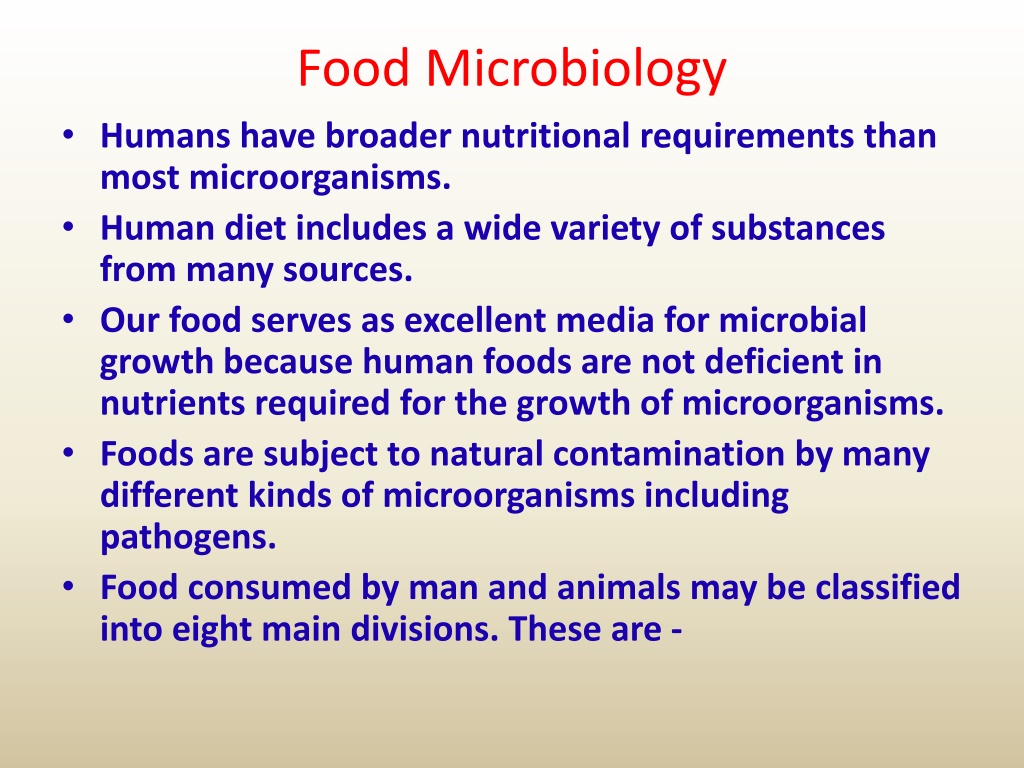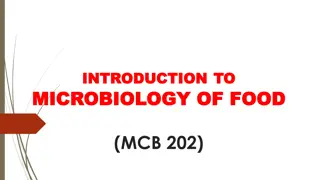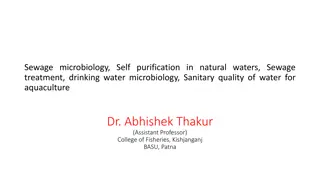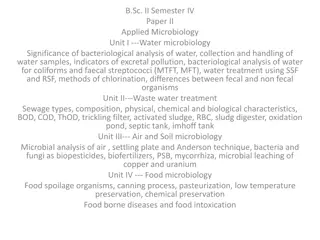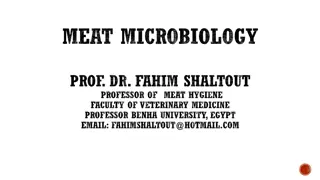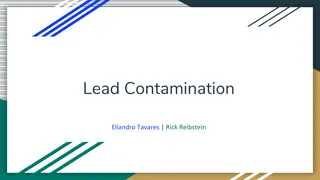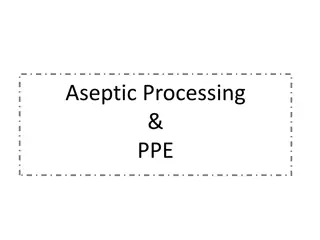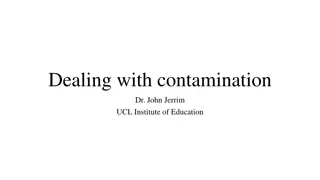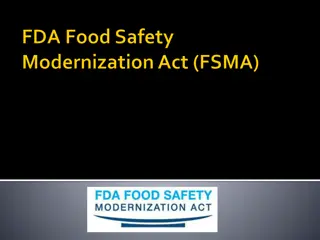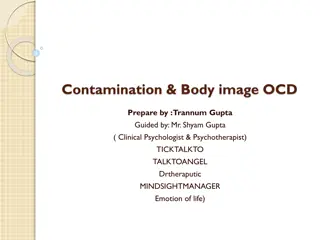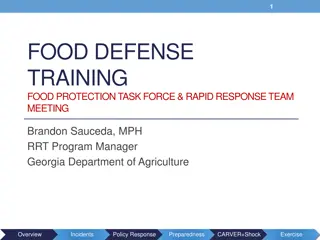Understanding Food Microbiology: Sources of Contamination
Humans have broader nutritional requirements than most microorganisms. The human diet includes a wide variety of substances, making our food excellent media for microbial growth. Natural contamination of food by various microorganisms, including pathogens, is common. Food consumed by humans and animals can be classified into plant and animal products, with classifications based on stability. Sources of contamination of fresh foods include sewage and soil, introducing human pathogens and other microorganisms to raw plant foods and seafood.
Download Presentation

Please find below an Image/Link to download the presentation.
The content on the website is provided AS IS for your information and personal use only. It may not be sold, licensed, or shared on other websites without obtaining consent from the author. Download presentation by click this link. If you encounter any issues during the download, it is possible that the publisher has removed the file from their server.
E N D
Presentation Transcript
Food Microbiology Humans have broader nutritional requirements than most microorganisms. Human diet includes a wide variety of substances from many sources. Our food serves as excellent media for microbial growth because human foods are not deficient in nutrients required for the growth of microorganisms. Foods are subject to natural contamination by many different kinds of microorganisms including pathogens. Food consumed by man and animals may be classified into eight main divisions. These are -
Unit V Food Microbiology Mr. S. N. Mendhe Department of Microbiology, Shri Shivaji Science and Arts College, Chikhli
1. Cereal And Cereal Products 2. Vegetables 3. Fruits 4. Milk And Dairy Products 5. Meat And Poultry 6. Eggs 7. Sea Foods 8. Sugar And Sugar Products. Broadly, these may be considered as plant products and animal products.
Classification of food Foods may be classified on the basis of stability 1. Perishable Foods such as meat and fish 2. Semiperishable Food such as potatoes 3. Stable Foods such as cereals, flour and sugar.
Sources of Contamination Of Fresh Foods The internal tissues of whole, healthy plants, fruits and animals are usually free from microorganisms. However, the external surfaces of plant products and animal products are contaminated by microorganisms from various sources.
1) From Sewage The domestic sewage contains human pathogens especially those causing gastrointestinal diseases and large number of other microorganisms. When sewage is used to fertilize the plant crops, there is a chance that raw plant food will be contaminated with human pathogens and others. Natural water contaminated with sewage contributes their microorganisms to seafood s such as shellfish, fish, prawns etc.
2) From Soil The soil contains the great variety of microorganisms. The soil contaminates the surfaces of the plants growing on or in them, and the surfaces of animal roaming over the land. Root crops such as potatoes, beets, carrots etc are coated with soil microorganisms. Low growing leafy vegetables such as lettuce (spinach) and cabbage are also heavily contaminated with soil microorganisms.
3) From Water Natural water contains its natural flora plus microorganisms from soil, animal and sewage. Water is used as an ingredient, for washing foods, for cooling heated foods, cleaning of containers etc. During these operations water contaminates the plant foods and animal foods.
4) From Air Air may contain several spoilage organisms and disease producing organisms. Air microorganisms contaminate plant and animal foods.
5) During Handling and Processing: The contamination of food takes place before the food is harvested or gathered or during handling and processing of the food. Additional contamination may come from utensils and equipment coming in contact with food. e.g. cans, butchering instruments (killing instruments), gloves etc. Additional contamination may also come from packaging material and from personnel s.
6) From Animal Itself: The hides (skin), hoofs, hairs, intestines, faecal matter of animal itself contains large number of spoilage microorganisms. Operation during killing, slaughtering (sacrificing of animals), de-feathering introduce organisms on the surface of animal food e.g. fresh eggs are usually free from microorganisms. But the egg shell may be contaminated with microorganisms from feathers, nest material, faecal matter etc. These organisms get in through the shell pores and contaminate the interior of egg.
7) Insects and Birds: Insects and birds causes mechanical damage to fruits and vegetables and introduce many microorganisms in it.
Preservation of Foods: The variety of methods for food preservation can be used depends upon the food and that can be done without alternating its desirable characteristics. Preservation usually involves preventing the growth of bacteria, fungi(such as yeasts), and other microorganisms. Modern methods of food preservation based on three general principles. 1) Elimination of sources of contamination. 2) Inhibition of the growth of spoilage causing microorganisms. 3) Destruction or removal of microorganisms present in food. The various methods employed for the food preservation are as follows: 1) Preservation of food by high temp. 2) Preservation of food by dehydration. 3) Preservation of food by low temp. 4) Preservation of food by high osmotic pressure. 5) Preservation of food by radiation. 6) Preservation of food by chemical preservative.
1) Preservation Of Food By Heat (High Temperature) : Many food products are preserved by the use of heat. It is one the safest and most reliable method of food preservation because heat is effective in destroying vegetative cells as well as spores. Temperature used during heat treatment is different for different foods. Heat treatment should maintain the test, flavor, texture and composition of food. It kills the Microorganisms by denaturating the microbial proteins, especially enzymes required for metabolism. Heat treatment processes may be classified as follows: Heating below 100 c (Pasteurization ) Heating at about 100 c (Boiling ) Heating above 100 c (Canning)
Heating above 100 c: Heating above 100 C is most effective and kills all vegetative cells and spores. It is generally applied to foods in the process of canning. Canning: Canning may be defined as a process of preservation of food packed in hermetically sealed containers by the application of heat above 100 c. Preservation of foods by canning was apparently started in the United State in 1879 by Underwood in Boston.
Canning process consists of following steps: 1) Cleaning: After receiving the raw food material in canning industry , it is cleaned by washing. It removes the dirt and as many microorganisms as possible. This reduces the microbial load 2) Sorting and Grading: Food is sorted to remove damaged food material. 3) Blanching and Scalding: The raw food materials are immersed in hot water at 87.5 c to 95 c or exposed to the live steam (having temp. of 100 c). This removes adhering materials which cannot be removed with cold water during cleaning. Blanching further lowers down the microbial load. 4) Peeling and coring: It removes surface soiling and associated microbial contamination. Various methods are employed such as steam peeling, flame peeling, mechanical peeling etc. 5) Filling of the containers: The food is then filled in cans or jars. Tin coated steel containers are generally used for this purpose.
6) Exhausting: The open filled containers are passed through an exhaust box in which hot water or steam is used. Exhausting expands food, drives out air/ gas bubbles and provides and atmosphere of steam in the head space at the top of the cans or containers. This excludes oxygen which may react with the food materials and the interior of the containers and may affect the quality of food. 7) Sealing: Each container is immediately sealed, after exhausting, before it is subjected to heating process. This prevents re-contamination of the contents. 8) Heat processing: The heat treatment depends upon several factors such as nature of food, type of food and size of container. Microorganisms are more easily killed in acid environment than in non - acid one. Penetration of the heat to the centre of the container depends upon the nature of food, solid or liquid. Heat penetration of solid food is relatively slower than that of liquid foods. A long heating period is required for larger containers than for small ones.
A long exposure at relatively low temperature is preferred to a shorter exposure at higher temperature to prevent damage by excessive heat. Acid foods are heated by steam under pressure at 212 f for the period of 5 to 15 minutes. Non acid foods are processed in retorts (cylindrical vessels) heated by steam under pressure at 240 f to 250 f (116 c to 121 c ) for a period as long as 1 to 2 hours. Meat fish, poultry are usually processed for 1 to 2 hours at 250 f (non acid foods) 9) Cooling: The processed containers are immediately cooled in air or in cold water. This prevents undesirable changes in texture and flavour. The can should be cooled to an average temperature of 37 c. 10) Labeling: The cooled containers are then labeled. 11) Warehousing and packaging: The cans of food product are then ware house (stored) and packed.
http://upload.wikimedia.org/wikipedia/commons/thumb/7/7e/PreservedFood1.jpg/220px-PreservedFood1.jpghttp://upload.wikimedia.org/wikipedia/commons/thumb/7/7e/PreservedFood1.jpg/220px-PreservedFood1.jpg http://upload.wikimedia.org/wikipedia/commons/thumb/d/d5/Spam_with_cans.jpeg/220px-Spam_with_cans.jpeg Spam is a canned and preserved meat product. Preserved food
Heating at about 100 0c Heating/boiling at about 100 0c is commonly used in the home as method of preservation. Boiling destroys vegetative cells rarely the spores. A temp. of approximately 100 0c is obtained by boiling a liquid food, by immersion of the container of food in boiling water or by exposure to flowing steam.
2) Preservation of food by Low Temperature Temperature around 0 0c or lower retards the growth and metabolic activities of microorganisms. This is mainly due to the formation of ice crystals in the cell of microorganisms. This cuts the membrane or coagulates the proteins of microorganisms. Due to this microorganisms at a low temperature does not perform any metabolic activity and cannot multiply. Thus preventing the spoilage, the low temperature is considered as microbiostatic.
METHODS:- Two methods are employed in the preservation of food by low temperature. 1) Chilling 2) Freezing Chilling (Cold Storage) :- The ordinary household refrigerators operating at 4-7 0c keeps most foods in palatable condition for a few days. In this method the temperature is kept just above the freezing point. This involves cooling by ice, or mechanical refrigerators. This does not prevent multiplication of all organisms. Chilled foods therefore, cannot be kept for many weeks. Microbial growth ceases only when food is solidly frozen. This method is applied to preservation of most perishable foods including eggs, dairy products meats, sea foods, vegetables and fruits.
Freezing ( Frozen Storage ) :- In this method, foods are frozen at the low temperature. By this method, foods can be stored for several months. In this method, properly prepared food is packed in containers or wrappers and subjected to freezing. Quick freezing is preferred to slow freezing. Quick freezing consist of freezing time of 30 minutes or less and the temperature between -18 c to -134 0C. Slow freezing requires 3-72 hours and temperature varies downward from -15 0C . Dehydrofreezing:- Certain foods such as fruits, vegetables, fish and mushrooms now are being frozen by means of liquid nitrogen (-196 0C) called dehydrofreezing. Deep freezers are readily available for this purpose.
C) Preservation of food by Drying Or Dehydration Preservation of food by drying has been practiced from several centuries. Most foods contain enough moisture which permits the action of enzymes and growth of microorganisms. This method is based upon the removal of water which is principle factor required for life. This dehydration or drying of food makes the product stable and inhibits the growth of microorganisms and their enzymes as well. Thus, the preservative effect of dehydration is mainly due to microbiostasis. Drying of food to less than 10% free water prevents the spoilage.
Methods of drying:- There are various methods of drying. 1) Sun-drying Sun drying is performed in climate with hot sun. This method is applied to certain fruits and vegetables. The fruits are spread out or trays and may be turned during drying. This is the natural method of drying. Examples - dried fish and dried rice noodle
2) Drying by mechanical driers:- This artificial drying method consists of the passing of heated air with controlled humidity, over the food to be dried. Number of devices is used for mechanical drying. The simplest drier is the evaporator or kiln. The tunnel drier is another mechanical drier used for thoroughly drying of fruits. Liquid foods such as milk, juices, soups, may be evaporated by using vaccum pan.
3) Freeze Drying (Lyophilization):- In this process, foods are frozen and then dried by means of vacuum and heat. This method is used for number of foods including meat, poultry, seafoods, fruits, vegetables and coffee. Food- Vaccum drying dried food. freezing at low temp -- Vaccum heated pan - frozen food freeze
Preservation of Food By High Osmotic Pressure:- Some foods are protected from microbial spoilage by the addition of high concentration of salt or sugar. The osmotic pressure of a solution depends on concentration of dissolved substances. (Salt/sugar) in solution. Solutions having extremely high osmotic pressure must be used top prevent the spoilage.
Mechanism: - High concentration of salt / sugar causes withdrawal of water from the cell. This causes shrinkage of the cytoplasmic content. This results in the inhibition of cell metabolism and it s growth, consequently followed by cell death. The salt concentration 20- 30 % usually prevents the growth of great majority of microbial species with the exception of few halophiles. Cane sugar in a concentration of 60-70% usually prevents growth of all the types of moicroorganisms.
Applications:- Salt is widely used to preserve certain foods. The salting and brining of fish, coring of beef (flesh of animal) and brining of green olives are examples of the use of high salt concentration. Salts are used for the preservation of other foods such as bacon (meat of pig), pork (flesh of pig) & anchovies (small fish marine). In the process of pickling , high concentration of salt with a very acidic environment is quite effective in controlling the growth of most spoilage causing microorganisms. Preservation of jellies, jams, honey, sweetened condensed milk and syrup is because of high sugar content which produces high osmotic pressure. Sugar is used to preserve fruits, either in syrup with fruit such as apples, pears, peaches, apricots, plums or in crystallized form where the preserved material is cooked in sugar to the point of crystallisation and the resultant product is then stored dry.
Preservation Of Food By Radiations (Radappertization) Foods can be sterilized by an appropriate radiation dosages. Radiations can sterilize the food with very little rise in temperature of the food product. This is frequently referred as cold sterilization. Radiations increases the storage life of food. Radiations both ionizing and non-ionizing radiations finds applications in the food preservation.
Ultraviolet Radiations (Non-Ionizing Radiations) : Ultraviolet radiation includes radiation from 150 to 3900 Ao. It is less energetic and does not ionize the molecule. U.V. radiation is used to kill the microorganisms, but U.V. radiations have less penetration power. Therefore, U.V. radiations are effective on the surfaces of food but do not penetrate the food. U.V. light around wavelength 2600 Ao has highest germicidal property.
U.V. radiations are used to kill the microorganisms on the surface of laboratory and food handling equipments. U.V. lamps are placed on ceiling of room to reduce the microbial population in hospitals, packaging rooms and in food, dairy and pharmaceutical industries. U.V. light kills the microorganisms by forming certain abnormal structure i.e. Thymine dimer (T=T) in DNA.
ii) Gamma rays : (ionizing radiation) : These are the ionizing radiation and are excellent sterilizing agent. These are the radiation of short wavelength and high energy. These radiations have great penetration power and penetrates deep into objects (about 15 cm in most food). Mechanisms of action:- they acts by pulling electrons away from molecules and ionize them and are therefore called ionizing radiation. When they pass through the cells, they form free hydrogen and hydroxyl radicals and some peroxides, which in turn reacts with cellular constituents and bring about damage to the cell.
Production :- gamma rays may be artificially produced from radioactive material such as Co-60. These radiations are emitted during radioisotope decay. Applications :- gamma rays have been used in the preservation of fresh perishable foods such as meat, sea-foods in paper or plastic bags. In some Countries, Gamma radiations are used to increase the storage life of fruits and vegetables. Gamma rays are used in the cold sterilization of antibiotics, hormones, sutures and plastic disposable materials such as syringes. However, this process has not been widely used because of high cost of production and concerns about the effect of gamma radiations on food. But in future it will be more extensively used.
Preservation of food by the use of Chemical Preservatives Some foods are preserved by the addition of chemical preservatives. Chemical preservatives are added to food to prevent microbiological spoilage. Chemical preservative either kills microorganisms or inhibits their growth. For a chemical substance to use as a food preservative, prior approval of food and drug administration is required. Several organic and inorganic compounds are used as chemical preservatives in food. These have marked microbiostatic and microbicidal action. Some of these chemical preservatives are added directly and some others are developed during fermentation of foods.
Name of chemical Organism affected Application SN Yeast and molds Preservative in bottled soft drinks, fruit juices, jellies, apples, tomato ketchups. Benzoic acid & benzoates 1 Prevents the growth of bacteria Preservation of butter. Boric acid 2 Sodium sulphite or sodium bisulfate or potassium bisulfate or sodium metabisulfite or potassium bisulfite Insect & microorganism Used as preservative, antioxidants, antibrowing agent in fruit juices, wines, dry fruits, syrups. 3 Inhibitory to bacteria Curing and meat & fish Sodium nitrite or sod.nitrate 4 Microorganism of diff. species Used as gas to treat drying fruits used in wine making process. SO2 5 Molds Breads, Cakes, some cheeses. Propionic acid & propionates (organic) 6 Molds Hard cheese, figs, syrups, jellies and cakes. Sorbic acid & sorbates 7
Inhibits microorganisms Inhibitory to microorganisms (bacteria) Preservation of fruits and vegetables (provides the acidity). Used as acid ulents, used in preservation of carbonated beverages. Cottage cheese. Produced within the food by pickles, sauerkraut, and fermented milk products. Used as acidulents in pasteurized cheese, sherbets, beverages. Preservative in fruit juices, soft drink beer, gas, storage of fruits & vegetables. Salicylic acid & sallicylates 8 Lactic acid 9 Inhibits microorganisms Inhibits microorganisms Acetic acid 10 CO2 / carbonic acid 11 Ethylene oxide/ propylene oxide (gas) Affects yeast & molds Used as fumigant for spices, nuts. 12
Fermented Foods Numerous fermented foods are prepared by fermentation processes. Microorganisms used in fermentation process are responsible for the characteristic flavor or texture, and sometimes for the keeping quality of the product. The preparation of idli, sauerkraut, pickles, olives, sausage, etc for humans and ensilage for animal fodder is the result microbial action on the original material. The fermented foods are more palatable and are not as easily spoiled. The microorganisms that produce the desirable changes may be the natural flora on the material to be fermented, or may be added as starter cultures.
They ferment the natural sugars in original material and yields organic acids, principally lactic acid, which serves as the preserving agents. Lactic acid fermentation is an anaerobic fermentation process. Both Homofermentative and Heterofermentative lactic acid bacteria participate in food fermentation. In some fermented food products, yeast and molds also participate along with lactic acid bacteria.
Examples of fermented foods: Idli Sauerkraut Pickles Olives Sausage Soy sauce Ragi Miso
IDLI Idli is a fermented food product & very popular traditional breakfast dish in south India. It is prepared from Rice and Black Gram Dal (Phaseolus mungo) which should be decuticaled. Both are washed with water separately. These are soaked in water separately. Then it is mixed thoroughly and grinded. The grinded paste is called as batter of idli. Batter of idli is kept overnight for 10 12 hrs, which brings about lactic acid fermentation. The natural flora of microorganisms present in batter of idli ferment sugar into lactic acid and gases.
Lactobacillus mesenteroids, Pediococcus cerevisiae & Streptococcus faecalis causes lactic acid fermentation. Due to lactic acid product becomes sour and due to gases it increases in volume & becomes spongy. Fermented batter of ldli is placed in idli pan. Idli pan then placed inside the cooker or vacuum pan and heated. Due to steam idli is cooked. Idli becomes very spongy just like bee hive structure. Idlis are usually served in pairs with Coconut chutney, Onion chutney or Sambar.
http://www.google.co.in/images?q=tbn:ANd9GcRj5CtW8nGxHf4NYeJDOHpaQVio0f1Lw8CA1g8Rp_TQ-9r97WHXuQ4KeDghttp://www.google.co.in/images?q=tbn:ANd9GcRj5CtW8nGxHf4NYeJDOHpaQVio0f1Lw8CA1g8Rp_TQ-9r97WHXuQ4KeDg http://www.google.co.in/images?q=tbn:ANd9GcQK8wagRJhg-YEsv3oIA1Wk6ihUJFx4_hfqUgMevXFoBObfpUMb1zIq-yg http://t3.gstatic.com/images?q=tbn:ANd9GcRuKTvR_7QgkpZiZteeI1mdtSKD8-YP_h19pk-osEGuwLzwjIVACFz-Irs Idli batter is poured into the round indentations of the idli pans and placed into a pressure cooker.
Sauerkraut Sauerkraut or sour cabbage is the clean, sound product of characteristic flavour, obtained by full fermentation (chiefly lactic acid fermentation) of properly prepared and shredded cabbage (pieces of cabbage) in the presence of 2 3 % salt. It contains 1 1 % of acid, expressed as lactic acid. Sauerkraut provides a high density source of a wide range of beneficial live bacteria which assist in the digestive process. Consuming of sauerkraut can give your body as much of a health boost. Sauerkraut is the German word for "sour cabbage", because of this, sauerkraut is thought of as a German invention although some believe that it was really invented by the Chinese over 2,000 years ago. Sauerkraut is an excellent source of vitamin A, C and vitamin B.
General making procedure Closely filled and fully matured heads of cabbage are preferred for kraut making and are wilted for (loosened) 1 2 days to bring the cabbage at a uniform temperature. Spoiled spots ad defective outer leaves are tried off. The heads are washed with pure water The head is cut to shreds of desired size. Then 2.25 to 2.5 % salt by weight is mixed with the shredded cabbage. Shreds are then packed into the jar or vats. Wooden frames are placed to tamp down the shreds. It keeps the shreds in submerged (anaerobic) condition. The combine action of salt and pressure draws out the juice containing the sugar and other nutrients. This is then subjected to lactic acid fermentation.
The temperature during the fermentation should be about 21 24oC.if the temperature is below 15.6 oC, the fermentation will be slow and incomplete and if above 26oC, abnormal fermentation may result. The juice contains the natural flora of cabbage plus contaminants from soil and water. At first, different kinds of bacteria begins to grow but the acid forming bacteria soon predominates. Leuconostoc mesenteroids predominates all over the organism and continues the acid production upto 0.7 1.0 % (lactic acid). Lactobacillus plantarum continues the acid production and raise the acidity to as much as 1.5 to 2.0 %.
These bacteria produces chiefly lactic acid in their fermentation of sugar. The final acidity of about 1.7% as lactic acid is most satisfactory. The fermentation requires 20 30 days to reach this acidity. When desired acidity is attained, the fermentation is stopped by canning. Good sauerkraut possess light colour with acidity of about 1.7% and a acid flavour. Acids, esters and diacetyl compounds produced during fermentation gives pleasant aroma and taste.
De-core the cabbage With the quarter-head on a cutting board, carefully slice the cabbage into shreds about the thickness of a dime. Put the cabbage shreds in a glass or ceramic crock. Put the cabbage shreds in a glass or ceramic crock. slice the cabbage into shreds De-core the cabbage Mix the salt in, and let the cabbage wilt for about an hour. Compact the shreds, and see how much liquid there is. Sprinkle the salt onto the shreds. Sprinkle the salt onto the shreds. Mix the salt in, and let the cabbage wilt for about an hour. Compact the shreds, and see how much liquid there is.
